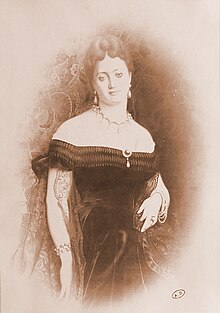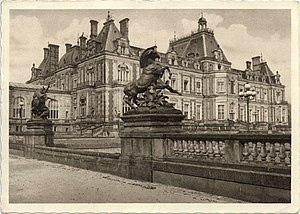|
Henckel von Donnersmarck
The Henckel von Donnersmarck family is an Austro-German noble family that originated in the former region of Spiš in Upper Hungary (now in Slovakia). The founder of the family was Henckel de Quintoforo in the 14th century. The original seat of the family was in Donnersmarck (Slovak: Spišský Štvrtok), which was then within the Kingdom of Hungary but is now part of Slovakia. The family was ennobled in 1607 by Rudolf II, Holy Roman Emperor. Members of the family were granted other noble titles and privileges in 1636 by Ferdinand II, Holy Roman Emperor, in 1651 by Ferdinand Charles, Archduke of Austria, in 1661 by Leopold I, Holy Roman Emperor, and in 1901 by Wilhelm II, German Emperor. In 1531, the family moved to Silesia. They were expelled from Silesia, along with other German families, in 1945 by the Soviet Army and settled in Germany and Austria. History In 1417, during the time of the Council of Constance, the Holy Roman Emperor and Hungarian King, Sigismund of Luxembourg, granted a coat of arms to the three brothers Peter, Jakob and Nicholas.[1] During the 15th and 16th centuries, John II (1481–1539), an eminent scholar, corresponded with Martin Luther, Erasmus of Rotterdam and Philipp Melanchthon. He began his career as a pastor in Levoča and Košice. Later, he stayed at the court of Louis II of Hungary and his wife, Maria of Austria. In 1531, he came to Silesia and became a canon in Breslau (Wroclaw), Silesia. He died there eight years later and was buried in the local cathedral. Lazarus Henckel (or Lazarus the Elder; 1551–1624) was a banker and mine owner, and the main financier of the Holy Roman Emperor Rudolf II's war against the Turkish Empire. Lazarus knew there was no way the Emperor would be able to repay him, but in return for his service, he was given a number of privileges. In 1607, he and his sons were ennobled with the surname von Henckel von Donnersmarck.[1] The family seat became the castle at Neudeck (Świerklaniec). BaronsIn 1623, the family received massive lands in Silesia from Emperor Ferdinand II in the form of pledged fiefs, which they purchased from the emperor only a few years later. Lazarus II (or Lazarus the Younger; 1573–1664), called the Lazy, was made Baron of Gfell and Vesendorff by the Habsburg emperor, Ferdinand II, at Regensburg in 1636. Counts In 1651, Archduke Ferdinand Karl of the Tyrol raised Lazarus' title to that of Count in the Habsburg Hereditary Lands. He received the same title in the Kingdom of Bohemia from Emperor Leopold I in 1661, that title being hereditary for all legitimate descendants, male and female, in the male line.[1] In 1697, the Henckels' inheritance of a Freie Standesherrschaft (Free Lordship), under the Bohemian crown, obtained Imperial confirmation as a hereditary Fideicommis, a family trust heritable by masculine primogeniture. There were only six families that ever obtained a free lordship, a status that meant the local aristocracy, even other Counts, had to pay homage (Huldigung) to the family, and that they had patrimonial jurisdiction, meaning they were legally sovereign and made their own laws and jurisdiction.  When at the end of the 3rd Silesian War in 1763, Austria lost Silesia to Prussia for good, the Henckel von Donnersmarck family became Prussian on paper. In reality, however, its loyalties stayed with the Habsburg family. The head of the Henckel von Donnersmarck family was even condemned to death personally by Frederick II of Prussia for staying loyal to the Emperors of Austria and was stripped of his entire estate. After he died in exile, Frederick II restored the family's fortune to his heirs.[2] Count Victor Amadeus Henckel von Donnersmarck became a Prussian general and governor of Königsberg. His granddaughter Ottilie married Johann Wolfgang von Goethe's son August, which is how Goethe's estate came to the Henckel von Donnersmarck family.  Count Wilhelm Ludwig Victor Henckel von Donnersmarck was a Prussian general who fought with Blücher to defeat Napoleon in the battle of Waterloo.  Finally, in 1854 and 1887, the family was given seats in the Prussian Hereditary House of Lords.[1] Hugo Henckel von Donnersmarck (1811–1890), head of the main (Catholic) branch of the family, became one of the central figures of the 2nd Industrial Revolution, spearheading technological innovations like mild steel puddling metal factories, three-high rolling mills and soda-pulping in Germany. At the beginning of the 20th century, Guido Henckel von Donnersmarck (made Prince in 1901, see below) was the second richest in Prussia after the Krupps.[3] He was the first German aristocrat to expand his holdings by raising capital through offering shares in a public limited company. He invited several illustrious figures to sit on the board of his companies, among them the Duc de Morny, the brother of Emperor Napoleon III. He invested in many different countries, including Sweden, France, Italy, Poland and Russia.[4] In his book Face to Face with Kaiserism, American Ambassador to Germany James W. Gerard describes how Guido Henckel von Donnersmarck jeopardized his wealth and position by writing an open letter to the Kaiser beseeching him not to annex Belgium.[5] Because of Guido Henckel von Donnersmarck's marriage to Esther Lachman (who was Jewish), and the marriage of Countess Veronika Henckel von Donnersmarck to Baron Erich von Goldschmidt-Rothschild (who was Jewish), the Henckel von Donnersmarcks were included in the Semi-Gotha by the Nazis, a Government-funded anti-semitic pamphlet attacking those aristocratic families that had married into Jewish families.[6][7] When after the Yalta Conference, Joseph Stalin and the communists claimed ownership of Silesia for Soviet-controlled Poland, virtually all Germans, numbering over 8 million, where driven out of Silesia, including the Henckel von Donnersmarck family, who had been there continuously since 1629. They lost their fortune, but soon re-established a position of importance. In 1958, Count Karl Josef Henckel von Donnersmarck married Princess Marie-Adélaïde, daughter of the Grand Duchess of Luxembourg and her consort, Felix of Bourbon-Parma, in what was the first televised royal wedding. In 2000, their son Count Heinrich Henckel von Donnersmarck became CEO of SIX Swiss Exchange, a company with a 2021 market cap of 2.4 trillion CHF. In 1964, George Cukor asked Countess Veronika Henckel von Donnersmarck (married to a Rothschild) to play the fictitious Queen of Transylvania opposite Audrey Hepburn in his production of My Fair Lady. Art director Cecil Beaton stated that, although she was not an actress, the Countess was the only lady in Los Angeles with the "impeccable deportment and breeding" necessary to play a queen. In 1997, Karl Josef's first cousin, Count Leo-Ferdinand Henckel von Donnersmarck, was elected President of the German Knights of Malta, a multi-billion dollar Catholic charity organization. In 1999, Leo Ferdinand's brother, Count Gregor Ulrich Henckel von Donnersmarck, was elected the 67th Abbot of Stift Heiligenkreuz, the famous 12th-century Cistercian monastery in the Vienna Woods. In 2007, Leo Ferdinand's son, film director Florian Henckel von Donnersmarck, received the Academy Award for Best Foreign Language Film for his spy drama, The Lives of Others. He went on to direct the 2010 blockbuster The Tourist with Angelina Jolie and Johnny Depp, nominated for three Golden Globes, and the 2018 epic drama Never Look Away, which was nominated for two Academy Awards. In 2013, he was named a Young Global Leader by the World Economic Forum.  PrincesOn 18 January 1901, Count Guido Henckel von Donnersmarck received the Prussian title of Prince from German Emperor Wilhelm II, heritable by masculine primogeniture.[1] He founded the Fürst Donnersmarck foundation in Berlin, currently endowed with 180 million euros, that employs over 600 people to help people with disabilities. His great-granddaughter, Anna Henckel-Donnersmarck, is the current curator and head of Berlinale Shorts, the Berlin Festival's short film competition. Notable family members
Notable members by marriage
References
Bibliography
Further reading
External linksWikimedia Commons has media related to Henckel von Donnersmarck family.
|
||||||||||||||||||
Portal di Ensiklopedia Dunia
